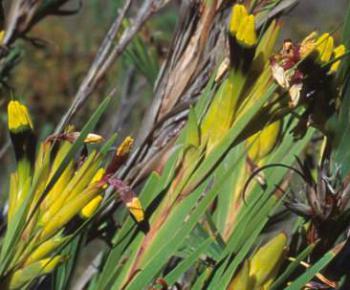Witsenia maura
Witsenia maura Thunb.
Family: Iridaceae
Common names: Bokmakierie's tail (Eng.); waaiertjie (Afr.)
Introduction
This plant is one of the most striking woody iris shrubs; very different from the familiar herbaceous genera such as the Iris and Gladiolus, but equally beautiful. It grows in marshy conditions.

Description
Description
Witsenia maura is a shrubby, evergreen iris with clustered fan leaves similar to the other two woody iris genera, Klattia and Nivenia. They have hard, brittle stems rare in the monocots. It is an erect or sprawling plant growing from 1-3 m in height. The leaves are narrow, 100-150 mm long and 40-70 mm wide at the base. It has six to eight flowers shading from pale-green to black. They are up to 85 mm long, occurring in pairs that are held together by three to five bracts. Each flower has pubescent (hairy) outer tepals, blackish in the lower half and yellow in the upper half, creating a brilliant display in winter, March-August. Witsenia maura is severely threatened by coastal development for urbanisation and recreation.

Conservation Status
Status
It has a Rare conservation status.
Distribution and habitat
Distribution description
It occurs from the southern Cape Peninsula through to Caledon, in marshy, low altitude locations. Records have been mainly in coastal areas with populations in the Cape Point Nature Reserve, Betty's Bay and Hermanus.
Derivation of name and historical aspects
History
Witsenia was the first woody Iridaceae genus to be described and was named Antholyza maura by Linnaeus in 1771. Its present name honours Nicholas Witsen, an eighteenth century Dutch patron of botany. It is speculated that maura refers to the similarity between the yellow tepals and the turban worn by Jews in North Africain past times. Maurus is an adjective for Moorish in Latin. The woody Iridaceae include only thirteen species. The genus Witsenia accounts for one, W. maura.
Ecology
Ecology
Pollinators include sunbirds and sugarbirds that enjoy nectar with 11-13% sugar content.
Growing Witsenia maura
Grow
This plant is not easily cultivated, even if planted in the same soil type and in marshy conditions. It is not readily available commercially and is therefore very important to conserve the existing Fynbos plant communities where this plant occurs naturally.
References
- GOLDBLATT, P. & MANNING, J 2000. Cape plants. A conspectus of the Cape Flora of South Africa. Strelitzia 9. National Botanical Institute, Pretoria & Missouri Botanical Garden Press, Missouri.
- GOLDBLATT, P., 1993. The Woody Iridaceae: Nivenia, Klattia & Witsenia. Systematics Biology & Evolution. Timber Press, Hong Kong.
- JACKSON.W.P.U. 1987. Origins and meanings of names of South African plant genera. UCT, Rondebosch.
Credits
Antonia Xaba
Harold Porter National Botanical Garden
June 2003
Plant Attributes:
Plant Type: Perennial
SA Distribution: Western Cape
Soil type: Sandy, Loam
Flowering season: Spring, Autumn, Winter
PH: Acid
Flower colour: Black, Yellow
Aspect: Full Sun, Morning Sun (Semi Shade)
Gardening skill: Challenging
Special Features:
Horticultural zones








Rate this article
Article well written and informative
Rate this plant
Is this an interesting plant?
Login to add your Comment
Back to topNot registered yet? Click here to register.